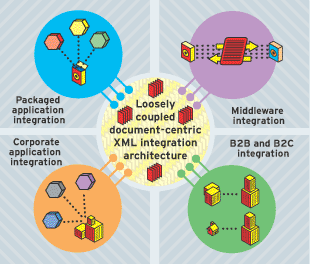Hurdles Abound In The Path To XML Integration
The proliferation of XML standards has opened the doors for solution providers who are integrating and streamlining enterprise systems, but the flurry of new techniques has created a complex web of access methods that have made the work largely inaccessible to mainstream developers. Companies including Microsoft and BEA Systems are alleviating the complexity by offering development environments that generate code and hide it, thus making the process easier. Still, overdependence on code generators has always limited what developers can do, and direct access to XML documents is a painful but necessary evil when integrating applications.

\
MARIO MOREJON
\
Technical Editor
A number of techniques have been made available in the past couple years by standards bodies such as the World Wide Web Consortium (W3C) and Organization for the Advancement of Structured Information Standards (OASIS) as well as vendors such as Microsoft and IBM that make it possible to parse and access XML files in multiple ways. The nature of each API in an access method is cumbersome and requires a deep understanding of how the XML documents are being traversed and consumed. There is a glimmer of hope, however: Most access methods actually overlap in some ways, so methods such as the XPath-XQuery model are versatile enough to cover over most data-processing models.
Allowing applications to communicate by exchanging and translating documents is another big integration hurdle for mainstream developers. XML schemas lay at the heart of today's XML integration methods due to XML's platform-independent properties. While XML schemas and Document Type Declarations (DTDs) have been used extensively and promoted by many vendors, they are quite complex and require expert knowledge of data mapping.
Schemas require a lot of parsing processing and are notoriously difficult to implement when validating multiple data exchanges within a document. Therefore, legacy application bridges that have been using object-based protocols or any other binary formats are not going anywhere. Even the component-based model that compiler vendors want customers to adopt still needs non-SOAP binary RPC-based protocols to form cross-platform application bridges. The messaging service hub model has created a lot of noise in the IT industry, but realistically, it should not be the only method of application integration.
With the Web Services Description Language (WSDL) interface, schemas have made it possible to decouple services from the rest of a system. When exposing trading documents to business partners, for instance, services are ideal. A good practice in managing all schemas in an enterprise is to develop a series of schema repositories that connect all schemas. Further, each schema should be reduced to a single task and work in conjunction with one another, similar to when executables call components.

\
Many enterprise systems can benefit from XML's distributed asynchronous architecture. Most EAI brokers already contain some form of XML mapping technology that helps developers transform data between applications. Since the format is represented in text, developers can quickly code connections between disparate systems. The drawback: Translating XML documents is complex and requires extensive testing. XML integration works best when simple single-task Web service methods or application components require distributed data connectivity.
Everyone, including the Electronic Data Interchange (EDI), has adopted the XML schema model. Schema-based APIs are also useful in packaged applications because they do not limit the customer to any single platform. Beyond that, solution providers should rely on integration brokers that provide multiple application connection options and automate schema validation. Using business languages as bridges are a totally different story. New languages such as XBRL (eXtensible Business Reporting Language) are truly helping extend the use of XML in areas that were previously difficult to implement. CPAs, for example, are using XBRL to exchange financial reports and manage financial documents more effectively by not having to waste time checking for errors in statements.
The potential for schemas in business processes are higher than their use in low-level application communication. Until now, the WSDL and schema implementation have been the foundation for Web services and have created a huge following across many industries. Test Center engineers believe that future W3C proposals are unlikely to replace XML schemas but enhancements to the XML-RPC model will be needed to achieve a pure-XML solution.
At the presentation layer of an enterprise application, XML is being adopted as the preferred method of integrating data because it is naturally suitable to carry data. Many vendors are promoting XML as the data carrier, including Microsoft, whose new line of Office 2003 products use XML extensively.
Portlets are another area where XML is being used to expose corporate data. Portal vendors now can exchange data without having to depend on proprietary access methods by using the new Web Services Remote Portlets (WSRP) standard. This standard will make portlets interoperable not just with data but with applications as well.
At the departmental level, the future of application integration may be controlled by business users. Products such as InfoPath are increasing the role of end users in application development and technologies such as WebDAV are allowing users and applications to communicate in ways that were never possible before.